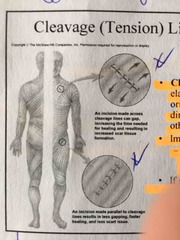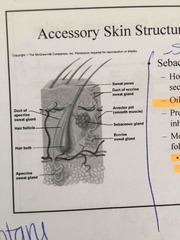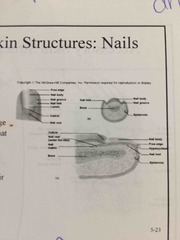![]()
![]()
![]()
Use LEFT and RIGHT arrow keys to navigate between flashcards;
Use UP and DOWN arrow keys to flip the card;
H to show hint;
A reads text to speech;
63 Cards in this Set
- Front
- Back
- 3rd side (hint)
|
The structures that are part of the integument are?? 4 of them |
Skin Hair Nails Glands |
|
|
|
What are the functions of the integumentary system? 6 of them VETSIP |
Protection Sensation Temperature regulation Vitamin D production Excretion Immunity |
|
|
|
Name the 3 layers of skin ...EDS |
Epidermis Dermis Subcutaneous tissue (hypodermics) |
|
|
|
What is the epidermis? ET |
The superficial layer of epithelial tissue |
|
|
|
What is the dermis? CT & SS |
Deep layer of connective tissue Structural strength |
|
|
|
What is the subcutaneous tissue? |
Not apart of skin Loose connective tissue that connects skin to underlying structures |
|
|
|
What tissue is the epidermis and dermis attached to? |
Subcutaneous tissue |
|
|
|
3 things about the Epidermis??? ASS |
Avascular - nourished by diffusion from capillaries of the papillary layer of the dermis Composed - of cells arranged into layers or strata (stratified) Separated - from the dermis by thin basement membrane |
|
|
|
What are the Epidermal cell type? 4 - KMDK |
Keratinocytes Melanocytes Desquamate Keratinization |
|
|
|
Explain the epidermal cell type Keratinocytes -4 |
They are most cells Protein/structural Produce keratin for strength Stratified squamous |
|
|
|
Explain the epidetmal cell type melanocytes - 4 |
Contribute to skin colour Melanin is colour pigment Melanin produced by these cells then transferred to keratinocytes Same # of melanin in all people |
|
|
|
Explain the epidermal cell type desquamate - 3 |
Cells of the deeper layers undergo mitosis Mitosis as they move towards the surface Than older cells slough off - dead skin cells |
|
|
|
Explain the epidermal cell type keratinization- explain |
As cells move outward through the layers They fill with keratin Than die Than serve as a layer that resists abrasion & forms permeability layer |
|
|
|
There are 5 layers of the Epidermal layer, what is the most superficial one? SC |
Stratum Corneum It’s a callus Dead cells Most superficial & consists of cornfield cells |
|
|
|
There are two types of skin what are they? TT |
Thick & thin |
|
|
|
Explain 3 characteristics about thick skin ... |
Has all 5 epithelial strata Found in areas of pressure or friction (palms of hands,soles & feet) Fingerprints and footprints |
|
|
|
Explain thin skin -3 |
Flexibility- more flexible than thick skin Covers rest of body Hair grows here |
|
|
|
What is a callus (skin) ? |
Thickening of the # of cells Increase in #of layers in stratum corneum Over a bony prominence, a Corn forms eg. Feet Cells - thicken because-of mechanical stress |
|
|
|
What 3 factors determine skin colour? PBT |
Pigments Blood circulating through skin Thickness of stratum corneum |
|
|
|
Pigments have 2 names . What are they? MC |
Melanin & carotene |
|
|
|
Explain melanin? |
Provides for protection against UV light Chemical derived from as tyrosine May be coloured brown to black- yellowish or reddish |
|
|
|
In melanin there are melanocytes & albinism explain the 2... |
Melanocytes- processes extend b/t keratinocytes Albinism - absence of pigment- determined by genetics, hormones . Exposure to light. No melanin |
|
|
|
Explain the carotene in skin colour??? Yellow |
Yellow pigment From veggies Accumulates in stratum corneum Too much yellow to red veggies In the adipose cells of the dermis & in the subcutaneous tissue |
|
|
|
Explain how blood circulation goes through the skin.. & Cyanosis |
Imparts reddish hue & increases during blushing , anger & inflammation Cyanosis- blue colour caused by decreased in blood oxygen content Blood is Always RED The thickness of the stratum corneum is always YELLOWISH COLD -skin is pale white Pink colour - flushed - thermos regulated - send more blood to skin |
|
|
|
The dermis is the working of the skin. Explain 2 things about the dermis... |
Gives structural strength. Connective tissues with many fibres. Contains nerves, blood vessels, hair follicles, smith muscles, glands and lympathic vessels Sensory function: pain itch temp. Touch pressure |
|
|

What is the cleavage (tension) lines? |
They are elastic and collagen fibres oriented in some directions more than in others -important in surgery- if incision parallel to lines, there is less gapping, faster healing & less scar tissue |
|
|
|
What does cleavage (tension) Striae mean? |
Skin is overstretch- stretch marks occur |
|
|
|
What are The type of cells of subcutaneous tissue? Cells? FAM |
Fibroblasts Adipose cells Macrophages |
|
|
|
What is another word for Subcutaneous tissue? HS |
Hypodermics Superficial fascia |
|
|
|
What are 5 things that the subcutaneous tissue do? HEHIP |
Half of bodies fat is stored deep to the dermis Half of bodies adipose tissue Energy use Insulation Padding |
|
|
|
Explain accessory skin structures HAIR.. |
Bulb is found in the dermis Found everywhere on body except palms, soles, lips, nipples, parts of external genitalia and distal segments of fingers and toes |

|
|
|
What are the growth and resting stages of hair? |
Growth- cells added at base and hair elongates. Growth per day 0.3 mm Resting- follicles shorten and holds hair in place . Rest than hair falls out of follicle. New hair begins |
|
|
|
Distinguish between regular and permanent hair loss? |
Regular is hair being replaced Permanent is hair loss pattern baldness |
|
|
|
What is hair colour caused by? |
Varying amounts & types of Melanin. |
|
|
|
Explain Arrector pili? Regarding hair structure |
It’s a type of smooth muscle. Muscle contraction cause hair to stand on end. Skin pushed up by movement of hair follicle Involuntary |
|
|
|
Sebum - sebaceous gland - oily secretion - prevents drying & May inhabit bacteria -EXCEPTIONS LIPS, meibomian, glands of eyelids , genitalia |

Back (Definition) |
|
|
|
What are 2 types of sweat glands? EA What is apocrine in glands? |
Eccrine & Apocrine |
|
|
|
What is Eccrine? |
Produces isotonic fluid Final product is Hyposmotic / hypertonic - sweat In palms and soles Not on lips and genitalia |
|
|
|
What is Apocrine in glands ? |
Secretion- organic compounds that are odourless but, when acted upon by bacteria may become odiferous Puberty- active- secretes organic compounds - stinky armpits, anus & genitals Bacterial by normal flora- metabolized in our own skin |
|
|
|
Talking about Glands, what are Ceruminous glands? Cerumen |
Earwax Modified Merocrine sweat glands External auditory meatus |
|
|
|
Talking about glands, what is mammary gland? MASG |
Modified Apocrine sweat glands |
|
|
|
What are nail structure? EH |
Eponychium/cuticle - nail body Hyponychium - under nail bed
|
|
|
|
What is the growth of nails? How much do they grow per day? |

0.5 to 1.2 mm/day faster than toenails |
|
|
|
What is the skins importance in thermoregulation? |
Skin to give off body heat by producing sweat if ur too hot Happens by secretion of sweat (water with electrolytes) from exocrine glands of the skin -dermis. |
|
|
|
What happens when sweat evaporates? |
We lose heat from the body, cooling us down |
|
|
|
How do you modify body heat? |
Through the control of blood flow through cutaneous blood vessels (blood vessels of skin) |
|
|
|
When blood is warm, how do we control blood flow? |
By controlling how much blood flows near the surface of the skin |
|
|
|
What happens when the body tries to loose heat? |
The body vasodilation (open up wider) the cutaneous vessels, thus causing more heat to be lost through the skin Appear to be flushed Pink/red when exercise |
|
|
|
When we are too cold, how do we conserve heat? |
By vasoconstrict (narrow blood vessels) to the skin in order to prevent heat loss through the skin (look pale) |
|
|
|
Know the difference between vasoconstriction & vasodilation |
Vasodilation- OPEN UP WIDER Vasoconstriction- narrow blood vessels |
|
|
|
What is Endogenous? |
Production of vitamin D Generated within the body |
|
|
|
How does vitamin D produce in the skin ? |
Begins when the skin is exposed to ultraviolet light |
|
|
|
What is vitamin D precursor ? |
It’s made in the skin Travels to the kidneys Than activated into the final working form vitamin D3! |
|
|
|
What is SLiK ? |
Skin Liver Kidneys |
|
|
|
How can we obtain vitamin D through our diet? |
Animal products like eggs Fortified milk- so kids and adults get enough |
|
|
|
How can we obtain vitamin D through our diet? |
Animal products like eggs Fortified milk- so kids and adults get enough |
|
|
|
Why are Canadians suffer from SADS? |
Seasonal affective disorder because of the winter Not enough sunlight - vitamin D |
|
|
|
Vitamin D is important process in the body, but there is just 1 that we focus on. What is it! AOC |
Absorption of calcium into the blood Increases Absorption of calcium from the GI track into the bloodstream |
|
|
|
Why is calcium important for our body? Bf C Mf Nf |
Bone formation Clotting Muscle function Nerve function |
|
|
|
How does skin protect our body? |
Keeps water in our body Keeps fluid inside body Regulates temperature |
|
|
|
What is sensation? |
Pressure Temperature Pain Heat Cold Touch Movement of hairs |
|
|
|
What is temperature regulation? |
Sweating & radiation |
|
|
|
What is excretion? |
Removal of wastes products from body - sweat water salt urea ammonia Uric acid |
|

